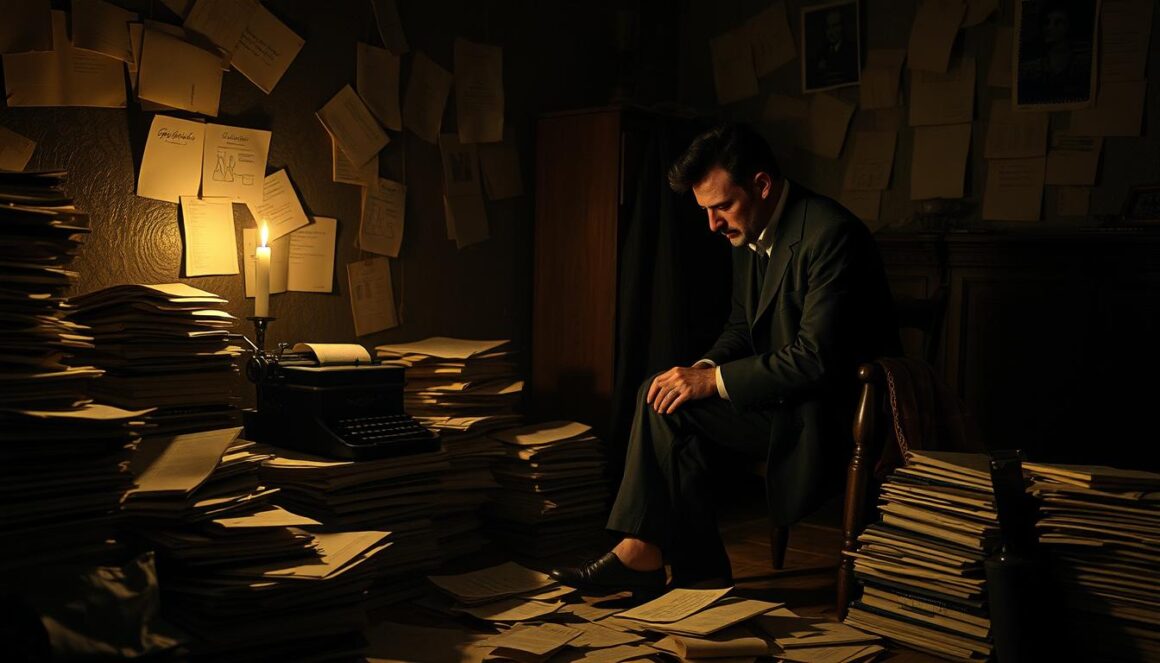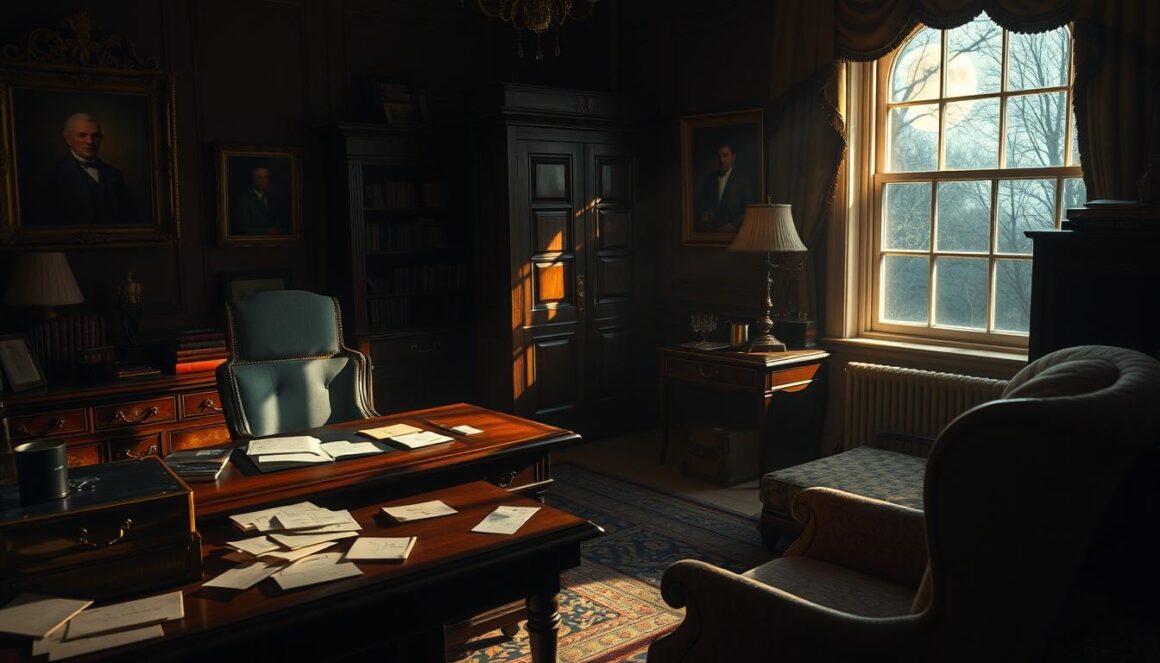History’s most famous figures have shared their deepest feelings through letters. These letters are full of scandal and capture our attention today. They show us the secret lives and forbidden loves of the past.
For years, these love letters were kept hidden. Now, they reveal the hidden passions and tumultuous relationships of famous people. These letters show us the human side of icons and the rules they faced in their secret affairs.
Artists, writers, world leaders, and royalty have all shared their forbidden loves through letters. This series explores their stories, revealing the power of love and the risks they took. Let’s uncover the secrets of these scandalous love letters together.
Napoleon Bonaparte’s Passionate Pleadings
The love letters between Napoleon Bonaparte and Josephine de Beauharnais are fascinating. They show the ups and downs of their secret love. Napoleon’s words to Josephine were full of passion, sometimes sweet and sometimes filled with jealousy.
In December 1795, Napoleon wrote a passionate letter to Josephine. He told her how much he missed her before they got married. But their love was complicated. Josephine had an affair with a French cavalry officer after Napoleon left for Italy in 1796.
Napoleon’s letters during this time were filled with sadness and anger. He was hurt by Josephine’s betrayal but still loved her deeply. One of his letters, found in 2007 in a Swiss basement, is a rare glimpse into their early days together.
Their marriage was full of drama. Napoleon was angry when he found out about Josephine’s affairs. He even thought about divorcing her in 1798. Their marriage was filled with strong emotions, power struggles, and fertility problems. They eventually divorced in 1809.
Henry VIII’s Desperate Declarations
The love letters between King Henry VIII and Anne Boleyn give us a peek into their royal romance. These letters, kept in the Vatican Library, show Henry’s deep love for Anne. They were written by the king himself, revealing his true feelings for his future queen.
Henry’s letters to Anne span several years. They show his deep vulnerability and determination. He talks about his sadness over her hesitation and his readiness to face her illness. The letters’ varied writing styles reflect the ups and downs of their relationship.
Thanks to these letters, we can see how important Anne was to Henry. They were sent to Pope Clement VII. These letters change how we view Henry and Anne, one of history’s most famous couples.
Virginia Woolf’s Intimate Inscriptions
The love letters between Virginia Woolf and Vita Sackville-West show the strong bond they shared. Woolf’s writing is full of poetic beauty and deep passion. These letters give us a peek into the world of same-sex love in early 20th century literature.
Woolf’s “A Room of One’s Own” is a key work in feminist literature, published in 1929. Meredith Perry’s thesis, “Exposure to Light,” explores how Woolf saw women as more than just stereotypes. Her characters in “Mrs. Dalloway” and “To the Lighthouse” break free from traditional roles.
Woolf’s letters to Sackville-West reflect her fight against societal norms. They show the complexity of same-sex relationships. These letters are important for understanding LGBTQ+ history and the power of literature.
Franz Kafka’s Tormented Texts
The story of Franz Kafka and Milena Jesenská is a fascinating tale of unrequited love. Kafka’s letters to Jesenská are filled with vivid imagery and deep emotion. They show his inner turmoil and intense feelings.
Kafka’s letters reveal his struggles with love and his complex personality. They offer a glimpse into his mind, one of literature’s most enigmatic figures. His relationship with his father deeply shaped his character and later relationships.
Interestingly, Kafka’s friend Max Brod had a deep fear of sex, despite being seen as more active. Brod’s diaries from 1909 to 1911 show his worries about unwanted pregnancies and diseases. The 1900s research on sexuality focused more on risks than pleasures.
Kafka’s own sexuality has sparked much debate. While some label him asexual or homosexual, his writings suggest a more complex reality. The shift to third-person narration in “The Castle” after a sex scene shows his struggle to accept his sexuality.

Unfortunately, much of Kafka’s work and personal correspondence remains unknown. An estimated 20,000 pages of his writings are held by Esther Hoffe’s daughters in Tel Aviv. Around 17 letters to his last lover, Dora Diamant, and 20 notebooks were lost after Diamant’s flat was raided by the Gestapo in 1933.
Despite the gaps and mysteries, Kafka’s “tormented texts” continue to fascinate readers and scholars. They offer a poignant look into literary romance, unrequited love, and the human experience.
Oscar Wilde’s Forbidden Feelings
In the Victorian era, Oscar Wilde’s letters to Lord Alfred Douglas, or “Bosie,” reveal their secret love. Wilde’s writing was as beautiful as his words in books. But their love was forbidden because of the strict rules of society.
Wilde’s letters to Bosie show how much he cared for him, comparing him to Hyacinthus from Greek myths. He called Bosie “My Own Boy” and “my dearest Boy,” showing a deep bond. Wilde also wrote lovingly to his wife, Constance Lloyd, calling her his beloved and saying he felt incomplete without her.
But Wilde’s love for Bosie led to his downfall. He was imprisoned for “gross indecency.” During his time away, he wrote “De Profundis,” a powerful 55,000-word letter. Wilde’s writings still move readers today, reminding us of love’s power and the harm of prejudice in the Victorian era.
John F. Kennedy’s Hidden Harmonies
Behind the scenes, President John F. Kennedy had a secret side. He shared private moments with Mary Pinchot Meyer through letters. These letters show a side of Kennedy that few knew, revealing his personal life and how he kept it hidden.
These letters give us a peek into Kennedy’s life. They show how he juggled his duties as president with his personal desires. Even with all the political scandals, Kennedy and Meyer kept their relationship private.

Kennedy and Meyer’s bond was strong and lasted for years. Their letters reveal Kennedy’s emotional side and his struggles with being president. They also show how he managed to keep his personal and public lives separate.
The discovery of these letters has made people curious about the personal lives of leaders. It highlights the challenges of keeping a public and private life under scrutiny.
Beethoven’s Unopened Utterances
In the 19th century, Ludwig van Beethoven’s letters to his “Immortal Beloved” are a big mystery. These letters show a side of Beethoven we rarely see. They are full of passion and poetry, unlike his public image.
Who Beethoven’s “Immortal Beloved” was has always been a big question. The letters, found after his death, talk about deep love and a desire for connection. But, the person he wrote to remains unknown, sparking endless debate.
Beethoven’s letters show how words can express deep feelings. His writing is both beautiful and honest, showing his inner turmoil. These letters give us a peek into Beethoven’s private life, making us see him in a new light.
The “Immortal Beloved” letters are a treasure that keeps us interested in history’s love stories. They remind us of the power of words to share human experiences. For years, Beethoven’s letters have fascinated people, showing the beauty of love and music together.
Conclusion: The Legacy of Historical Love Letters
Historical love letters give us a peek into the personal lives of famous people. They show us the real side of these icons, beyond what we see in public. These letters raise questions about privacy and how we remember people, but they are still very interesting.
Letters from Napoleon Bonaparte and Franz Kafka are just a few examples. They show us the depth of human emotions and relationships. These letters help us understand how love can change lives, societies, and even politics.
These love stories, kept in letters, show the lasting appeal of romantic legacies. When we read these historical correspondence, we get a glimpse into the past. It lets us see the personal and often private turned public lives of those who shaped history.




